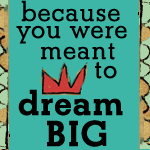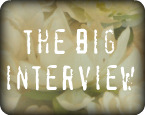Yvonne Carmichael is the curator of Art in Unusual Spaces, a scheme which opens up empty shop units in city centres for use by artist as project or exhibition spaces, inspiring and sometimes surprising busy shoppers. Artworks so far have ranged from miniature prams to giant robots and from den-making to really short artist films. Yvonne shares her thoughts on exhibiting art from a curator’s perspective.
Ingrid-Berton Moine's short artist film as part of 'Short Shorts: Very Brief Artist Films in the window of 42 New Briggate', Decemver 2009. Part of Art in Unusual Spaces. Photo with permission from Yvonne Carmichael
How did you find yourself doing what you do?
I studied an Interdisciplinary Art and Design BA at Leeds College of Art and on the course was a module focusing on collaboration. It was about this time things seemed to click, leaving the studio and meeting other artists working in the city made me realise that being involved in art might actually be something I continue doing after I graduated.
It was through connections made on the course I ended up co-curating 42 New Briggate - an empty shop unit next The Grand Theatre in Leeds. In the beginning this was in partnership with Opera North; putting on exhibitions which accompanied their productions next door in the theatre. Then in between the opera seasons there was time to work with artists on independent projects. Programming the two strands of the space was really exciting, the balance between having funding and a brief for some projects and other being much more self-directed was really great opportunity for me and I learnt a lot in a short space of time.
Whilst studying I was particularly interested in how artworks are presented to audiences. The final steps in deciding how to display or articulate what artworks are about are often vital to the audience's reception of that work. A lot of people who work in the arts wear lots of different hats from day to day, which is something I really enjoy.
What does a day in the life of an independent curator look like?
It really depends what kind of show you are working on. With Art in Unusual Spaces I seem to spend a lot of time carrying things from one shop unit to another - chairs, lights as well as washing windows, installing vinyl lettering (a very stressful time-consuming task, I can assure you), updating websites, writing press releases, getting hold of keys for shop units and of course meeting with artists and talking through projects.
Do you only curate exhibitions of art that speaks to you? What kind of art are you drawn to?
With Art in Unusual Spaces I like the artwork to respond in some way to the spaces. The shop units aren't white cube gallery spaces and have a more mixed audience than a gallery does. I like it when artists are prepared to experiment. I also find discussing projects with artists as they develop really interesting. Art In Unusual Spaces is also different to curating a gallery in that I rarely deal with completely finished bodies of work – rather I work with artists to help realise their ideas.
I like artwork where the audience and 'exhibition' space have been considered in the making of the actual work. I am also drawn to work which has a playful approach. This can often provide entrance points into the world of contemporary art for people that aren't familiar with it.
What makes an outstanding exhibition? What would be your advice to artists preparing for their first major show? How can they make it special?
I enjoy exhibitions which are ambitious and experimental. I think that it's often important to be honest about what you are doing and why you are doing it. I find it frustrating when artists succumb to the pressure of 'over-hyping' or over-explaining their work. This often leads to disappointment. Audiences can make their own opinion about work and it can be off-putting when artists tell them how fantastic their own work is.
When putting on exhibitions for the first few times it is easy to forget about marketing the event. This is the same for any kind of event I suppose, the focus is placed on getting the actual event together and letting people know about it is left until the last minute. The balance between the two things is something I am still learning. Artwork should be for everyone, not just people who might already know about it, and I think getting feedback from new audiences is always important.
Being able to collaborate is usually really key when putting on an exhibition, it's often not possible to organise everything yourself and it can certainly be a lot more fun if there is a group of people involved.
How important was your art education in helping you choose a life that lets you do what you love?
I gained a lot from my degree. I was very wide-eyed and keen when I was a student partly because I hadn't done a foundation course so felt I had a lot of catching up to do. The course involved regularly presenting yourself and your work, which at the time seemed to get in the way of the actual projects. In hindsight though, it has stood me in good stead. I am more able to communicate projects in their really initial stages to lots of different kinds of people. Also, I did workshops in many different mediums and processes (glass, wood, metal, jewellery, photography, film, photoshop and drawing). Though I'm by no means an expert in any it has provided me with an overview that has really helped me to be able to mediate for lots different artists.
Studying is great in that it provides a well needed excuse to spend time researching, exploring and learning and takes the focus away from doing paid work.
Why is public art important?
It depends what kind of public art you are talking about; prefabricated bronze sculptures that you might see in front of an office block are less inspiring than research-based and socially-engaged projects. I do appreciate, however, that one of public art's functions is to make places more attractive!
I think it's important that the public engage with art because it can help people think about places differently by offering new narratives. For example with a piece of work I did with the artist collective Black Dogs in Holbeck we helped people think about the area differently through guided walks and installations that played on the Italian and industrial heritage of the area.
Also, more generally, art provides an experience where the audience has to make up their own mind about the 'meaning' something carries so it can be a kind of training in critical thought; it isn't entirely consumptive or passive. I think art outside a gallery is often more interesting and thought provoking because it provides these experiences in a non-specialised space and can be more surprising.
For more info on Yvonne's work see her website
***
For more inspiring interviews with people doing what they love see here
Sunday, 8 August 2010
Subscribe to:
Post Comments (Atom)























What a fascinating job and read, thanks Beth. I think its a great use of shop space, we are doing something similar in my local town. We call it Windows on Washington (street) - "WOW" which i think is a cool name and I love "Art in unusual places" too so very very cool. Will definitely come visit Leeds when im next over, the art scene looks great! (and of course you and your lovely new home are there too)Under 6 weeks to Squam - woop woop! Xx
ReplyDeletereally interesting interview Beth! that's something i always thought would be cool work! thanks for posting this!
ReplyDeletethank you so much for this interview! it's been very inspiring reading and i love seeing things from a different perspective :)
ReplyDelete